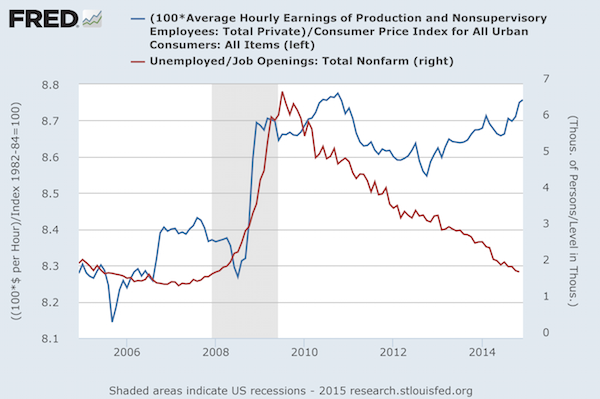An interesting survey from the Bureau of Labor Statistics which has started to get a lot more coverage is the Job Openings and Labor Turnover survey, or JOLTS for short. In a limited time (literally only since 2000), JOLTS has proven useful in revealing statistics on why workers leave their jobs, and also in revealing the actual number of open positions yet to be filled.
Mix those statistics with the general unemployment statistics and you can find some interesting trends - albeit, again, only on a short scale (which makes it tough to say anything definitive.
The Unemployed Worker to Job Opening Ratio
One of those series is the total nonfarm job opening measure - a crude measure, perhaps, but also a nice glimpse into the health of the economy's businesses. You aren't hiring if you're contracting, for the most part...
For today's article, we'll mash that up with the total number of unemployed workers, versus non-supervisory worker hourly earnings and inflation (measured by CPI) - and find that we recently crossed a threshold - there are now less than two unemployed worked for every open position! Specifically, there are 1.8 unemployed workers for every job posting - down from 6.8 in July of 2009. the best this measure has ever seen is 1.4 in March of 2007 - so if March 2007 sounds like boom times to you, we've still got a bit to run.
The blue line, of course, means 'real' raises, as in above inflation (can't be losing income to rising price levels, can we?).
Anyway, having less workers competing for each job can only be bullish from the perspective of wages - although, perhaps it is bearish if you believe the investing hypothesis that corporate margins are at a record (and unsustainable) high. They would, of course, contract in a period of sustained wage pressures - and we would also see increased inflation.
Regardless of whether the recent increases in real wages are just noise or real, this is definitely a ratio to watch in the future. Hopefully we'll take you back to revisit this more in the future - whether in boom times, or bust.

